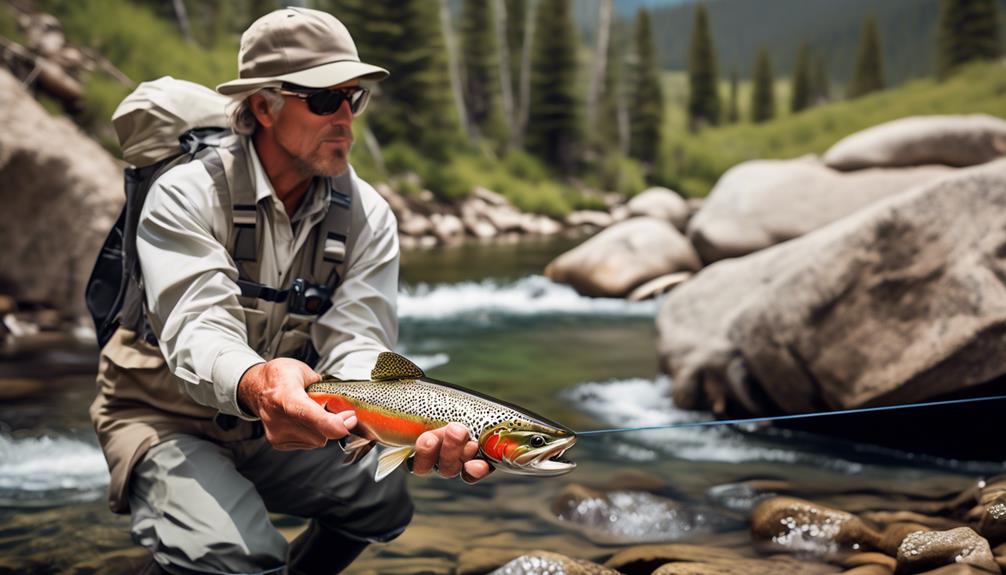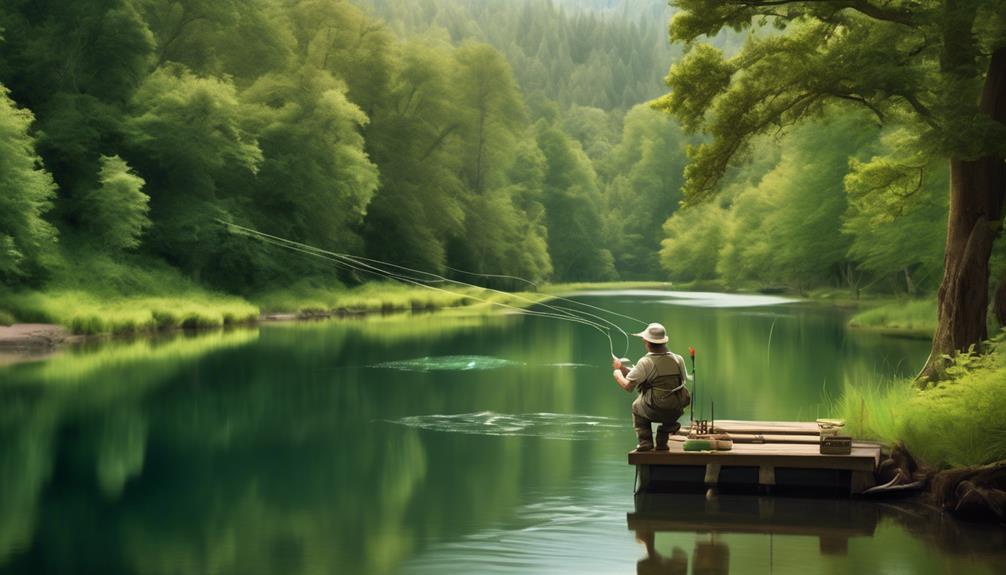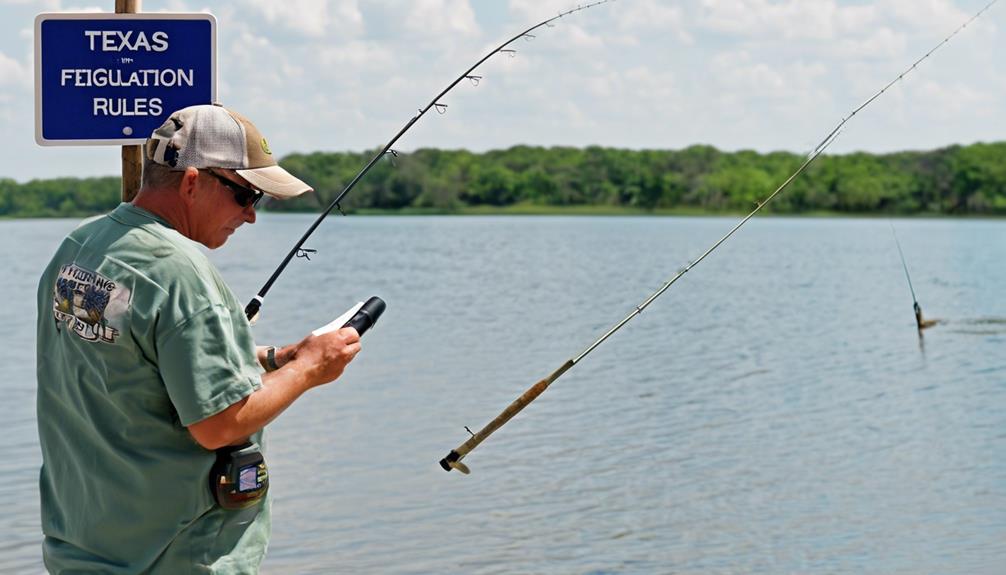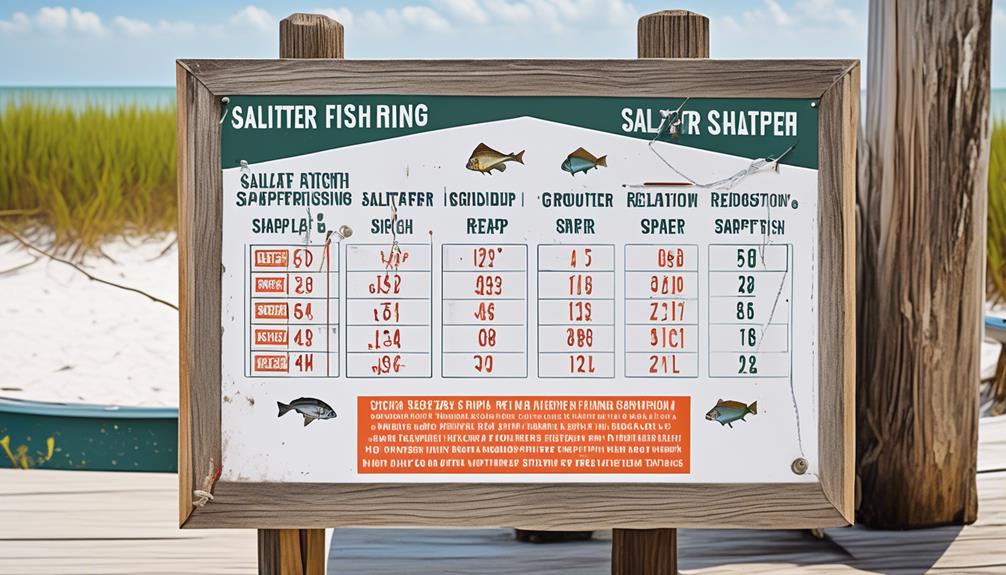You might think that catching a trout in the Rocky Mountains is a simple task, but when it comes to the essential regulations for trout fishing, there's a lot more to consider than you might realize.
From specific licensing requirements to catch and release guidelines, the rules are designed to ensure the sustainability and health of the trout population.
But there's one crucial regulation that every angler needs to be aware of, and it can make or break your fishing trip.
Licensing Requirements
To legally fish for trout in the Rocky Mountains, you must obtain a valid fishing license from the state wildlife agency. The license fees vary depending on whether you're a resident or non-resident angler. Residents usually enjoy lower fees compared to non-residents. These fees contribute to conservation efforts and the maintenance of the fishing resources. It's essential to understand the fishing regulations and have the necessary fishing education before obtaining a license. This education can often be acquired through online resources, local workshops, or by taking a fishing education course.
Before purchasing a fishing license, it's important to familiarize yourself with the different types of licenses available. Some states offer annual, multi-year, or lifetime licenses, while others provide short-term options for tourists and visitors. The state wildlife agency usually offers comprehensive information on their official website or at their offices. The fishing education provided not only ensures that you understand the rules and regulations but also promotes responsible and sustainable fishing practices.
When obtaining your fishing license, make sure to have all the required documents and information ready. This may include proof of residency, personal identification, and in some cases, a social security number. Once you have your license, be sure to keep it with you at all times while fishing, as wildlife officers often conduct random checks.
Catch and Release Guidelines
Before purchasing a fishing license, ensure that you understand the catch and release guidelines to promote sustainable fishing practices in the Rocky Mountains. Catch and release fishing is a valuable conservation tool that helps maintain fish populations and preserve the natural environment. When done properly, it minimizes the environmental impact and allows for the enjoyment of fishing for generations to come.
As an angler, it's your responsibility to handle fish with care during catch and release. This means using barbless hooks, which can be easily removed without causing excessive harm to the fish. It also involves minimizing the time the fish is out of the water and handling them with wet hands to avoid damaging their protective slime layer. Properly releasing the fish in a gentle manner ensures their best chance of survival after being caught.
Understanding the environmental impact of catch and release is crucial. Releasing fish unharmed back into the water allows them to continue their vital role in the ecosystem, maintaining a balanced food chain and contributing to the overall health of the fishery. By following catch and release guidelines, anglers contribute to the conservation of fish populations, ensuring that future generations can also enjoy the thrill of catching trout in the rivers and lakes of the Rocky Mountains.
Size and Possession Limits
Ensure you're aware of the size and possession limits in place when fishing for trout in the Rocky Mountains to comply with regulations and contribute to sustainable fisheries management. These limits are crucial for maintaining healthy fish populations and minimizing the environmental impact of angling activities.
Size limits specify the minimum length of trout that can be legally harvested, while possession limits dictate the maximum number of fish an angler can keep. Adhering to size limits helps safeguard fish populations by allowing them to reach maturity and reproduce before being harvested. This practice is essential for maintaining a sustainable balance within the ecosystem, ensuring that there are enough adult fish to sustain the population. By respecting size limits, you directly contribute to the conservation of trout populations, promoting their long-term viability and the overall health of the aquatic environment.
Possession limits are equally important in preventing overexploitation of trout populations. These restrictions control the number of fish an angler can keep, preventing excessive harvesting that could lead to a decline in fish numbers. By adhering to possession limits, you play a vital role in preserving the natural balance of the ecosystem and minimizing the environmental impact of fishing activities.
Understanding and abiding by size and possession limits are fundamental responsibilities of anglers. By doing so, you actively participate in the conservation of fish populations and contribute to the sustainability of trout fisheries in the Rocky Mountains.
Fishing Season Dates
Plan your trout fishing trips in the Rocky Mountains by noting the official fishing season dates to ensure compliance with regulations and maximize your angling opportunities. The fishing season in the Rocky Mountains typically runs from late spring to early fall, but specific dates can vary based on the location and local weather conditions. It's crucial to check the exact season dates for the specific area you plan to visit, as they can differ between different access points and bodies of water.
When planning your trout fishing excursions, be mindful of the local weather patterns. The Rocky Mountains are known for their unpredictable weather, and conditions can change rapidly, especially at higher elevations. Before heading out, check the weather forecast for the area and pack accordingly. It's essential to dress in layers and be prepared for sudden shifts in temperature or unexpected precipitation.
Special Trout Waters Designation
As you explore the trout fishing season dates in the Rocky Mountains, it's important to understand the designation of Special Trout Waters and how it can enhance your angling experience. Special Trout Waters are specific areas that have been identified for their exceptional trout populations and are subject to special regulations to conserve these valuable resources.
Here's why these designations matter for you:
- Enhanced Conservation Efforts: Special Trout Waters receive increased attention from wildlife management authorities, leading to stricter regulations and conservation efforts. This ensures that the trout populations are protected and sustained for future generations of anglers.
- Improved Fishing Experience: Due to the conservation efforts and habitat protection in Special Trout Waters, anglers are more likely to encounter healthy and abundant trout populations, enhancing the overall fishing experience.
- Wildlife Habitat Protection: These designated areas not only benefit trout populations but also contribute to the preservation of diverse wildlife habitats. By respecting the regulations in these areas, you contribute to the protection of the entire ecosystem.
- Opportunities for Education: Fishing in Special Trout Waters provides an opportunity to learn about conservation and the importance of protecting natural resources. It allows anglers to appreciate the value of sustainable fishing practices.
- Community Involvement: Special Trout Waters often attract a community of like-minded conservationists and anglers who are dedicated to preserving these valuable resources. Engaging with this community can provide valuable insights and contribute to ongoing conservation efforts.
Understanding the significance of Special Trout Waters can lead to a more fulfilling and sustainable angling experience while contributing to broader conservation efforts and wildlife habitat protection.
Artificial Lure and Fly Only Areas
Artificial lure and fly only areas are designated sections of the Rocky Mountains where fishing is restricted to the use of artificial lures and flies, providing a unique angling experience for dedicated anglers. In these areas, traditional bait fishing is prohibited, and anglers must rely on their skill in casting and retrieving artificial lures or flies to entice trout. This fishing technique requires a higher level of finesse and precision, making the catch even more rewarding for those who enjoy the challenge.
The implementation of artificial lure and fly only areas serves an important purpose in preserving the natural environment. Unlike bait, which can potentially harm fish if swallowed deeply, artificial lures and flies are more likely to hook fish in the lip, reducing mortality rates and minimizing the environmental impact of catch-and-release fishing. Additionally, by promoting the use of artificial lures and flies, these areas help maintain a healthier trout population by preventing overfeeding and the spread of diseases that can occur when fish are repeatedly exposed to bait.
Furthermore, these regulations contribute to the overall conservation efforts in the Rocky Mountains, ensuring that the delicate balance of the ecosystem is preserved for future generations of anglers. By respecting the boundaries of artificial lure and fly only areas and embracing the challenge of this specific fishing technique, anglers play a vital role in protecting the natural beauty and diversity of trout in the region.
Bait Restrictions
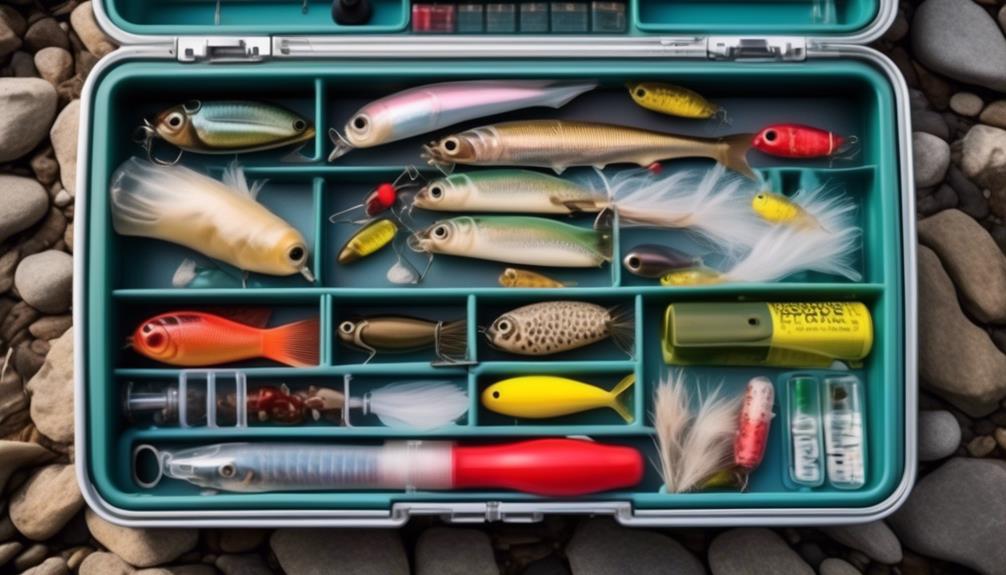
Consider using a natural bait that's allowed within designated areas to attract trout and comply with bait restrictions. When fishing in the Rocky Mountains, it's important to be aware of the specific regulations regarding bait usage to ensure the sustainability of the trout population. To help you navigate these regulations, here are some key points to consider:
- Lure types: In areas where bait restrictions are in place, it's crucial to familiarize yourself with the types of lures that are permitted. Common options include artificial flies, spinners, and jigs. These lures are designed to mimic natural prey and can be highly effective in enticing trout.
- Bait options: While many areas enforce bait restrictions, there are still opportunities to use natural bait in designated zones. Nightcrawlers, mealworms, and salmon eggs are often allowed in these areas, providing anglers with alternative options to attract trout.
- Regulatory signage: Pay close attention to any signage or information provided by local authorities regarding bait restrictions. These signs will clearly outline the rules and permitted bait options for the specific fishing area.
- Conservation impact: Understanding and adhering to bait restrictions is essential for the conservation of trout populations. By complying with these regulations, anglers can contribute to the preservation of the natural ecosystem and ensure that trout populations remain healthy and abundant.
- Ethical angling: Adhering to bait restrictions demonstrates responsible and ethical angling practices. By respecting these regulations, anglers can enjoy the sport of trout fishing while also upholding principles of conservation and sustainability.
Local Fishing Regulations
To ensure compliance with local fishing regulations in the Rocky Mountains, familiarize yourself with the specific restrictions and guidelines set by authorities, including those related to bait usage. When it comes to fly fishing techniques, certain areas may have regulations that dictate the types of flies or lures that can be used, as well as the specific methods allowed for catching trout. Make sure to check local regulations to ensure that you're using appropriate fly fishing techniques in each area.
Conservation efforts are a top priority in the Rocky Mountains, and fishing regulations play a crucial role in preserving the delicate ecosystems. Many local regulations are designed to protect fish populations and their habitats. For instance, there may be guidelines on catch-and-release practices, as well as restrictions on the size and quantity of trout that can be harvested.
It's essential to be aware of these regulations and to actively support conservation efforts by adhering to the rules.
Frequently Asked Questions
Can I Fish for Trout in the Rocky Mountains Without a Fishing License?
You can't fish for trout in the Rocky Mountains without a fishing license. The penalty for fishing without a license can include fines and even potential legal consequences. Make sure to obtain the necessary license before fishing.
Are There Any Specific Areas in the Rocky Mountains Where Catch and Release Is Not Allowed?
You can fish for trout in the Rocky Mountains without a fishing license in some areas, but catch and release may not be allowed in specific areas due to regulations. Always check the rules before fishing.
Are There Any Exceptions to the Size and Possession Limits for Trout in the Rocky Mountains?
Yes, there are exceptions to the size and possession limits for trout in the Rocky Mountains. These exceptions are put in place as conservation measures to protect the trout population and ensure sustainability.
Can I Fish for Trout in the Rocky Mountains Year-Round, or Are There Specific Fishing Season Dates I Need to Be Aware Of?
You can fish for trout in the rocky mountains year-round. Some of the best fishing spots are along the rivers and streams. Try using fly fishing techniques for catching different trout species, such as rainbow and brown trout.
Are There Any Specific Regulations for Fly Fishing Only Areas in the Rocky Mountains?
When fly fishing in the Rocky Mountains, be aware of specific regulations for designated fly fishing zones and conservation areas. Some areas may have fly fishing restrictions or limited access points to protect the local trout population.
Conclusion
So, when you're heading out for a day of trout fishing in the Rocky Mountains, make sure you have your fishing license, know the catch and release guidelines, and are aware of the size and possession limits.
Be mindful of the fishing season dates and any special trout waters designation. And don't forget to check for any artificial lure and fly only areas, as well as bait restrictions.
Always be sure to follow local fishing regulations to ensure a successful and responsible fishing trip.
